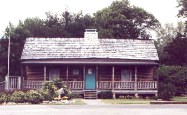Welcome To Cherokee Trail Of Tears Commemorative Park
Located In Hopkinsville KY
 This historic park is one of the few documented sites of actual trail and campsites used during the forced removal of the Cherokee people to "Indian Territory". It was used as an encampment in 1838 and 1839. This park is the burial site for two Cherokee Chiefs who died during the removal - Fly Smith and Whitepath. This long, cruel relocation has become known as the "Trail Of Tears" and by Native Americans as "The Trail Where They Cried". In December 1987, President Ronald Reagan signs a bill creating the Trail Of Tears as a
This historic park is one of the few documented sites of actual trail and campsites used during the forced removal of the Cherokee people to "Indian Territory". It was used as an encampment in 1838 and 1839. This park is the burial site for two Cherokee Chiefs who died during the removal - Fly Smith and Whitepath. This long, cruel relocation has become known as the "Trail Of Tears" and by Native Americans as "The Trail Where They Cried". In December 1987, President Ronald Reagan signs a bill creating the Trail Of Tears as a  National Historical Trail and Hopkinsville KY is named in the bill. In April, 1996 the National Park Service designated the park as a certified site on the National Historic Trail Of Tears. Our park is the first non-federal property to receive such designation.
National Historical Trail and Hopkinsville KY is named in the bill. In April, 1996 the National Park Service designated the park as a certified site on the National Historic Trail Of Tears. Our park is the first non-federal property to receive such designation.
Statues of Chief Whitepath and Fly Smith were crafted by local artist Steve Shields and were unveiled with delegations from Eastern Band Of Cherokees and Cherokee present. One of the focal points of the Trail Of Tears Commemorative Park is the log cabin which serves as the Heritage Center of the Park.This cabin dates to the Trail Of Tears itself. While in need of reconstruction, the cabin was moved to the park with only its roof removed. A complete restoration was done, a new porch built and the interior fitted with display cases for the cabin's new life as a Heritage Center.There are seven Cherokee clans. Bird, Paint, Deer, Blue, Wolf, Long Hair, Wild Potato. Near the burial area in the Park,The Trail Of Tears Commission has planted seven Red Cherokee Chief Dogwoods in honor of each clan. The name of each clan is set forth in a carved redwood sign by its tree.
Every year on the first full weekend after Labor Day, the Trail Of Tears Commission sponsors an intertribal PowWow at the park. The PowWow for 2007 will be held in September on the first full weekend after Labor Day September 8th and 9th 2007. A PowWow is many things....A gathering of Native American people to celebrate their rich heritage; to socialize with old friends and make new ones and an opportunity to expose non-indians to the centuries old tradition of the various dances and Native American crafts; and to educate the PowWow visitors with story telling and Indian lore demonstrations.
 Free Forum Hosting
Free Forum Hosting